4 Challenges of Microsoft 365 Licensing
Microsoft 365 License Management is important, but not always easy
Microsoft 365 is a powerful...


Cloud services like Microsoft Azure and Microsoft 365 are continuing to grow at rapid rates. Microsoft’s overall revenue in FY20 Q2 was $36.9 billion which means 14% growth compared to the corresponding period of last fiscal year. The Office 365 portion growth was 27% (up 30% in constant currency).
Microsoft introduced the Microsoft 365 suite in August 2017 as an additional enterprise package alongside Office 365. It contains the Office 365 features, Windows 10 Enterprise, and Enterprise Mobility + Security. With so many license options and various ways to achieve your organizations goals, how do you choose which option to go with? Should you buy Office 365, Microsoft 365, E3, E5, and some add-ons? This blog post covers the Microsoft enterprise licensing jungle from an IT pro perspective.
Note: there are also Office 365 F1 and Microsoft 365 F1 plans for frontline workers available. As these users don’t present most of an enterprise organization, I will not cover these licensing plans. (Additional information on Microsoft licensing costs.
The best-known subscription package is probably Office 365 – whether E3 and E5 as shown in the picture below.
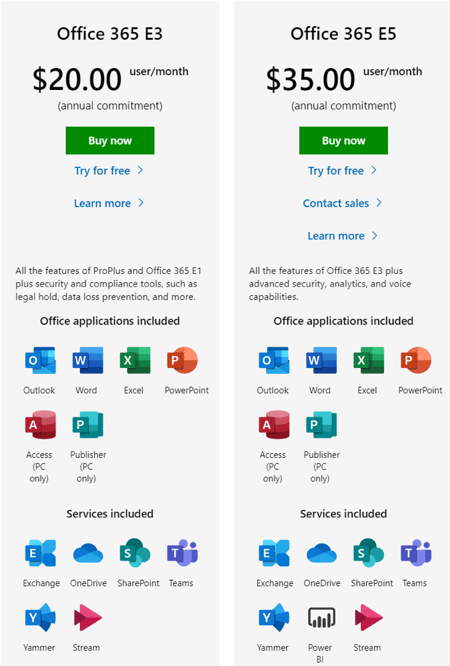
During my initial customer meetings, I often hear that there is no real difference between Office 365 E3 and Office 365 E5 and that the “lower price subscription is sufficient for our needs. Why should we spend $15 more for every user?” Looking at Microsoft’s Office 365 plans comparison page, it’s not very clear what features are available with the E5 plan. In fact, there is no detailed description of all these features visible. In practice, it is probably impossible to document all features and changes on one page. As an example, audit logs are retained for 90 days for users who are licensed with Office 365 E3, and 365 days for users who are licensed with Office 365 E5. Furthermore, the mobile device management features like InTune and Mobile Application Management (MAM) are missing completely.
For this reason, there are supplementary plans available. For the mobile device management and security part, there is an Enterprise Mobility + Security add-on offered. Like the first two Office 365 plans, these can be divided in E3 and E5 as well:
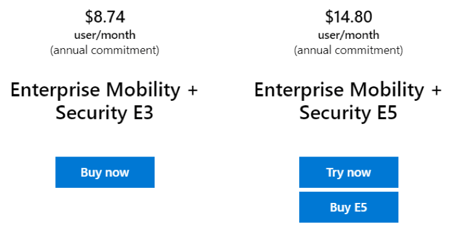
The difference between these two plans are in the little but important details. Based on the documentation, EM+S E5 offers the following additional features compared to EM+S E3:
However, when this blog was written, there are more features included in EM+S E5, like AAD Access Reviews and AAD Entitlement Management that were not documented here. Thus it’s hard if you don’t know the feature itself or where you should have a look at to find more information.
In addition, there are different plans within the Office 365 ATP subscription available: ATP Plan 1 (formerly standalone) and ATP Plan 2 (formerly Threat Intelligence standalone). That is not to be confused with Azure ATP which offers security features for cloud- and hybrid environments, like monitoring your identities and devices to detect anomalies.
In contrast to the Office 365 plans, there are two Microsoft 365 enterprise plans available:
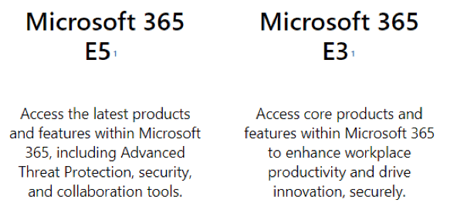
There are no details about the pricing for the enterprise (E) plans public available because interested users should contact sales for more information. You can have a look at your existing tenant to get the (regular) pricing information, in my case it’s the currency EUR because my tenant is based in Europe:
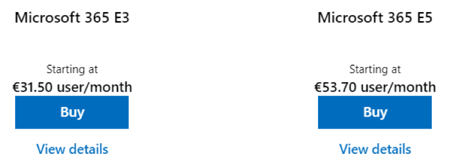
The main difference between Office 365 and Microsoft 365 is basically the EM+S package and Windows 10 Enterprise, which are included in Microsoft 365. As the name suggests, Microsoft 365 E3 contains Office 365 E3, EM+S E3, and Windows 10 Enterprise.
It could be a little tricky to decide which plan is right for your organization and to compare all the features and available add-ons in detail. Often times, pricing is the most critical factor for organizations.
Depending on your contract details – whether you are using an EA or CSP subscription – licensing plans and add-ons can be added, changed, and removed on a daily, monthly, or yearly basis. This means you are not bound forever to your subscriptions and changes can be made very quickly to fit your organizational needs.
A good entry point for an enterprise organization is Office 365 E3. This plan covers all basic applications like Exchange, Teams, Planner, Office ProPlus etc. Also, multi-factor authentication is free and covered in every available enterprise plan. But when it comes to security features like mobile device management to protect your devices and data from theft or unauthorized access, you need at least an EM+S E3 add-on. I highly recommend the EM+S E3 suite for every user in your organization. In a mobile-first, cloud-first world your users can work with every device, everywhere in the world and this data should be protected as much as possible.
If the additional charge of about $7 for Windows 10 Enterprise is worth it, you should consider the Microsoft M365 E3 plan, which covers all features of Office 365 E3, EM+S E3, and Windows 10 Enterprise. It’s always a good idea to calculate the costs of your volume licensing program and compare it with the overall costs of the Microsoft 365 E3 subscription per year.
From an IT pro and security perspective the E5 plan – whether as an add-on or included in Office 365 E5 and Microsoft 365 E5 – offers additional benefits. For example, you can use PSTN conferencing with Microsoft Teams as the phone system add-on is included in every E5 license, otherwise it costs $8 per user/month.
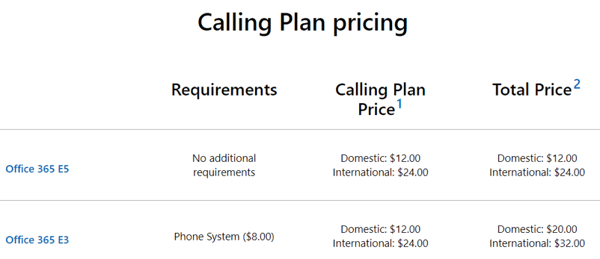
Administrator accounts should consider an E5 plan as well, because of the increased audit logging retention time of 365 days. Furthermore, Privileged Identity Management offers an easy way to delegate admin roles for your administrators without the need of a permanent global administrator role. Besides PIM, another useful feature is AAD Access Reviews and AAD Entitlement Management which requires an ATP Plan 2.
There’s no one size fits all approach to licensing, thus it’s very difficult to list all features and give recommendations that make sense for all enterprise organizations. However there are some considerations I will mention. E5 licenses are a great choice, however that does not mean every user within your organization needs an Office 365 E5 or Microsoft 365 E5 license. Users who only work with users within your organization probably have no need for PSTN conferencing capabilities and therefore a lower tier license may be appropriate. Additionally, Office 365 Advanced Threat Protection to use Safe Links or secure your Exchange, OneDrive, and SharePoint environment with additional security features. Depending on the number of users and the organizational security and compliance regulation, it makes sense to buy the complete E5 plan or, for example, only add the Office 365 ATP plan to a certain number of users.
Managing Office 365 licenses is no easy task and forecasting for future needs can be exhausting. At ENow, we believe in ‘buy only what you need, and adopt all that you buy’, and our solutions can help you achieve just that.
Efficiently and effectively optimize your Office 365 licenses to make informed licensing decisions with ENow Office 365 License Management reporting, including: customizable trend analysis, real-time licenses user lists, license addition history, and much more.
Access your free 14-day trial today! Be the IT hero and drive out any hidden costs.

Dominik is a Microsoft MVP primarily specializing in Microsoft Exchange, Exchange Online and Office 365. Dominik currently works for a German consulting company, AtWork. At atwork, Dominik focuses on designing and building message infrastructures and cloud technologies. Dominik has worked in IT since 2004, primarily with Exchange Server but also has experience with Windows Server, Active Directory, Azure, Office 365, Unified Messaging and various third party products.


Microsoft 365 is a powerful...


As organizations and their executives place an even greater emphasis on resiliency, IT leaders face